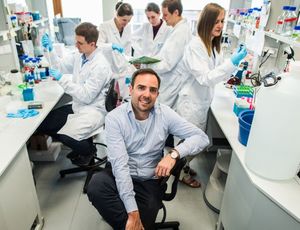
An international team of researchers from the Max Planck Research Group at the Małopolska Centre of Biotechnology (MCB) deciphered the molecular mechanism of a sulphur carrier system that stands at the root of all eukaryotic ubiquitin-conjugation systems.
In this project, the team headed by Dr Sebastian Glatt from the Jagiellonian University collaborated closely with the group of Prof. Sebastian Leidel at the Department of Chemistry and Biochemistry of the University of Bern (Switzerland). The results of their research have recently been published in The EMBO Journal.
“Ubiquitin is a small protein found in all cells of eukaryotic organisms, from yeast to human beings, which reflects its ubiquitous, omnipresent character. It acts like a label that is attached to a specific protein in order to mark it, usually for degradation. Ubiquitination is the process of marking proteins with ubiquitin, performed by three proteins with different enzymatic activity. It is a specific and controlled process allowing the degradation of proteins that are abnormal, damaged, or simply of no use at a given moment. Besides degradation, ubiquitin can also direct proteins to other part of a cell or to participate in a given cellular process”, explains Dr Marta Pabiś, the lead author of the paper.
The study provides the first structural and mechanistic insight into the eukaryotic Uba4-Urm1 system, which is essential for the transfer and incorporation of sulphur into transfer RNA (tRNA) bases. Perturbation of these specific modification pathways results in protein homeostasis defects and has been linked to neurological disorders and cancer in humans.
The team obtained the first three-dimensional atomic model of the E1-like sulphurtransferase, Uba4, with its bound substrate, the Ubiquitin-like protein (UBL), Urm1. The crystal structure of the Uba4-Urm1 complex provides molecular insights into substrate recognition and the enzymatic reaction cascade. In addition, the authors deciphered a critical role of an active site residue that protects Uba4 from its own reaction product. As this feature appears to be conserved in all other E1 and E1-like activating domains, the observed covalent E1-UBL self-conjugation reaction likely represents the evolutionary ancestor of most UBL pathways. The discovery of the Ubiquitin-mediated proteolysis has received the Nobel Prize in 2004 and involves thousands of cellular proteins. UBLs and the underlying degradation pathways have been the focus of many academic and industrial projects, aiming to exploit them as diagnostic markers, drug targets and molecular drugs themselves.
tRNA thiolation factors Urm1‐Uba4 represent the most ancestral known ubiquitin‐like protein/E1 enzyme conjugation system, whose structural mechanisms have however remained elusive. Here, crystal structures and complementary biochemical and cellular analysis of fungal Urm1‐Uba4 show that it combines features of bacterial sulphur‐relay pathways and eukaryotic ubiquitin conjugation systems.
 Dr Pabiś explains that “UBL protein modifications in eukaryotes might have evolved from prokaryotic sulphurtransferase systems and our study provides further evidence that the Uba4-Urm1 system represents that missing ‘molecular fossil’“. The second lead author from the MCB, Keerthiraju E. Ravichandran, adds “with great power comes great responsibility – the Uba4-Urm1 system has taken its responsibility and protected itself from its own product. Thereby, it allowed the creation of a whole universe of novel cellular signalling pathways.” Dr Glatt summarizes “our work provides a milestone in understanding the dual character of this system and provides deep molecular insights in the underlying mechanisms.”
Dr Pabiś explains that “UBL protein modifications in eukaryotes might have evolved from prokaryotic sulphurtransferase systems and our study provides further evidence that the Uba4-Urm1 system represents that missing ‘molecular fossil’“. The second lead author from the MCB, Keerthiraju E. Ravichandran, adds “with great power comes great responsibility – the Uba4-Urm1 system has taken its responsibility and protected itself from its own product. Thereby, it allowed the creation of a whole universe of novel cellular signalling pathways.” Dr Glatt summarizes “our work provides a milestone in understanding the dual character of this system and provides deep molecular insights in the underlying mechanisms.”
The work was mainly funded by the First Team Grant (FirstTEAM/2016-1/2) from the Foundation for Polish Science. In addition, the MCB Structural Biology Core Facility (funded by the TEAM TECH CORE FACILITY/2017-4/6 grant from the Foundation for Polish Science) provided crucial support and essential equipment.





